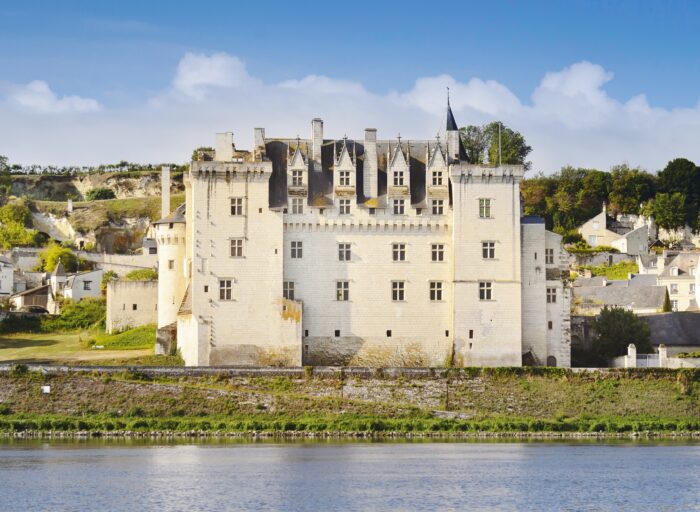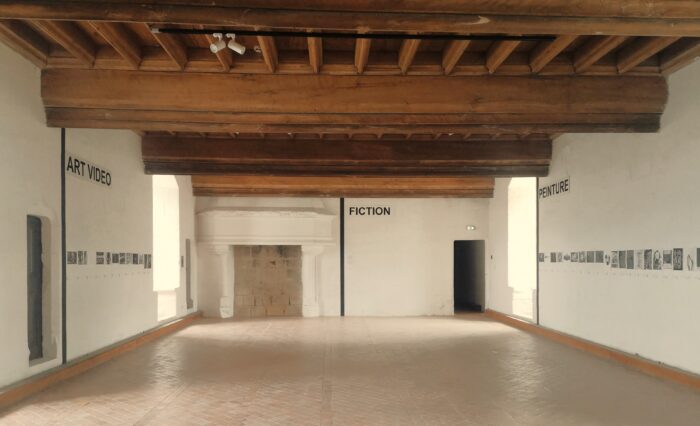
The Conceptual Olympiad at the Château de Montsoreau – Museum of Contemporary Art, inspired by the innovative spirit of the Paris 2024 Olympics, transforms the historic château into a nexus of avant-garde ideas and artistic exploration. Emerging and established artists converge in this picturesque Loire Valley setting, redefining the boundaries of contemporary art through a conceptual challenge conjured up by Philippe Méaille and Marie Caroline Chaudruc, with Lara Pan as a consultant on the project. The Conceptual Olympiad celebrates creativity as its own form of athletic prowess, emphasizing intellectual agility and imaginative depth. As participants engage with themes ranging from cultural identity to environmental stewardship, the château pushes the boundaries of traditional art exhibitions by inviting a global community of artists to participate. I’m sitting down with Philippe, founder and president of the Château de Montsoreau, to learn more about this exhibition.
–
Philippe, obviously the Olympics inspire athletes and spectators alike, while especially offering a sense of excitement for host countries. When did this idea for a similarly stimulating competition occur? What are some thematic connections that exist between the two events?
First, I want to express a personal sentiment that I deeply share with Marie-Caroline Chaudruc. We regret that our world remains divided by borders, and we both believe that art has always been conceptual. By treating country names as labels or locations rather than political entities, we had the opportunity to showcase the diversity of artistic expression at a specific moment in time. This approach also allowed us to highlight the core Olympic values of friendship, respect, and excellence. To achieve this, we established a highly constrained framework for the exhibition: each artist was asked to choose one category from ten and invited to submit a digital file so their work could be printed on a single black-and-white A4 page.
There are many examples of competition within the contemporary art world, such as the Venice Biennale and the Turner Prize. We seized the opportunity presented by the Paris 2024 Olympics to reactivate an art competition based on principles similar to those of the ancient Greek games.

The Château de Montsoreau has undergone various transformations and uses since its construction in the 15 th century, including serving as a residence, a prison, and now as a museum of contemporary art. The walls have housed a plethora of changes, but ultimately the château was destined for creativity. In what ways does the Conceptual Olympiad push the boundaries of a traditional art exhibition and how does it fit in with the realm of conceptual art?
This is a very challenging question. I don’t believe this exhibition fits within the realm of conceptual art. In fact, I question whether a distinct realm of conceptual art even exists in a rigid sense. Conceptual art, emerging in the 1960s, focuses on ideas and concepts over traditional aesthetic and material concerns. It is not, however, blind to their existence.
Since the 1970s, personal computers have become a reality, and people gradually accepted the duality of owning, on one side, their computer (hardware) and, on the other side, the software that allows the machine to function. How this fits into the history of conceptual art is complex. Nevertheless, I am certain that both the computer world and the world of conceptual art were acutely aware of each other’s existence and significantly influenced each other. The rise of digital art and the use of computers by conceptual artists testify to this intersection.
Traditionally, we associate a chateau or the Olympics with cultural heritage, a specific location, or a significant event. However, if we shift the paradigm and consider them as entities with their own narratives and roles, their messages and actions in a contemporary context become more evident.
Your jury is made up of countless professionals in the art world, including French curator Éric de Chassey, prominent collector Sandra Hegedus, Nicholas Ballet, Bernard Marcadé, and prominent gallerist Michèle Didier and support from the prestigious Art and Language group. Can you describe your reaction to such a collaborative project and if it aligns with any long-term goals of the château? What are you hoping to achieve with this exhibition?
The jury, led by its president Eric de Chassey (director of the National Institute of Art History), was put together with an emphasis on the international scope of the exhibition and our desire for diverse perspectives on the artworks. Joining Eric de Chassey are Sandra Hegedüs (collector and patron), Nicolas Ballet (curator at Centre Pompidou), Bernard Marcadé (art critic and historian), and Michèle Didier (gallerist). The artists of Art & Language support the exhibition and have designed the trophy that will be awarded to three winners in each of the ten categories.
Lara Pan has gathered 151 artists from close to 100 countries for the exhibition. Eight months ago, this exhibition was just an idea. Given that the Chateau de Montsoreau welcomed the Olympic flame in its courtyard on May 28th, and considering that the Olympics of Culture were traditionally held in a different location from the traditional Olympics, it made perfect sense to think about reactivating them on this occasion. We have been very fortunate that this idea was embraced by so many artists and art professionals, making it a reality. In fact, this is just the beginning, and I am looking forward to discussions both with the jury and the visitors.
In 2018, we installed a monumental work by Art & Language titled A BAD PLACE in the courtyard of the Chateau de Montsoreau – Museum of Contemporary Art. It could signify “we are A Bad Place”, that the place we are in is “A Bad Place”, or that art is “A Bad Place”. For some reason, it became a motto. We are more than happy to welcome people here to keep the discussion of art alive.

Lara Pan’s work as an international curator has likely fostered new global relationships between artists and the Château over the last few months. How has it been for you to work with Lara as a consultant – especially for a project of this scale?
This exhibition is highly improbable – and to organise it in such a short time, even more so. It has been greatly influenced by the generosity of conceptual artists and curators. There is nothing particularly new about its concept or layout. Nonetheless, making it a reality required taking a certain risk, and I think that the three of us—Marie-Caroline, Lara, and I—are gamblers in that sense. (Don’t misunderstand me; I see a gambler as someone who makes calculated decisions.) Aside from that, it involved a lot of work, and we truly enjoyed every part of it.
What makes this exhibition a success is the response of the artists and the quality of the works we received. Lara would be more suited to answer this question in detail, but I can say that in sending their work the artists had to address numerous challenges: the competition itself with its categories, the values of the Olympics, the planned destruction of the entire exhibition at its conclusion, and the highly constrained framework and timeline. Despite these constraints, the artists were given complete liberty regarding the content of their works. And Lara was able to ensure that we received no withdrawals of submissions by the artists. In fact, I still don’t understand how she managed to collaborate with artists across five different continents or geographical regions.
You are the biggest collector of the Art & Language group in the world. How did you get interested in this work and when did you start to collect? You mentioned that the Art & Language group created a trophy for the Conceptual Olympics, tell us more about how this idea developed?
My first encounter with a work by Art & Language was almost 30 years ago. Beyond my initial intuition, there have been numerous experiences over the years that have proven even more affirmative and significant. Overall, this story reads like a classic fairy tale. They all start similarly, with everyone young and beautiful, the world seemingly in disarray, and in need of a touch of magic. My story began with the Mirror Piece (1965) by Art & Language.
The creation of the trophy for the Olympics stemmed from discussions between us and Art & Language, where we decided against awarding works of art with Gold, Silver, or Bronze. While art can sometimes serve as a form of currency, in this case, we felt it was more fitting for the trophy to be another work of art. Our conversations led us to the idea of 1980s video games, where the message of victory was always “YOU WIN.” It was an idea that both we and Art & Language and us couldn’t resist.

After the impressive debut of the Conceptual Olympiad, are there plans to expand this initiative for the upcoming LA Olympics? How do you intend to build on the success of the Château de Montsoreau event and collaborate with international art professionals to continue showcasing the fusion of contemporary art with global cultural celebrations?
The Paris 2024 Olympics, in collaboration with the International Olympic Committee, aimed to celebrate the 100th anniversary of the Paris venue by promoting contemporary culture. It is expected that the Los Angeles Olympics also will prominently feature Contemporary Art. We are open to collaborating with other institutions and with your support would be enthusiastic about organizing another Conceptual Olympiad for future Olympics.
It is always difficult to say that an exhibition is successful in all respects. On the contrary, we put this exhibition together with the ambiguities and complexities represented by each category in mind, both for us and hopefully for the artists as well. Rather than being doctrinaire so as to create a ‘dream’ exhibition, we aimed to help the artists convey what they were really working on and to show how their vision could transform our institution or impact the lives of our visitors. And we hope that art professionals will continue to consider our institution in the future.
—
The Conceptual Olympiad is on display from 14 June to 11 August 2024. This exhibition has enabled artists living in one of the 203 countries taking part in the Olympic Games to compete in one of the ten categories defined in the rules: painting, drawing, poetry, music, video art, sculpture, performance, fiction, installation and photography – an artistic competition that echoes the most demanding of outdoor athletic disciplines.


